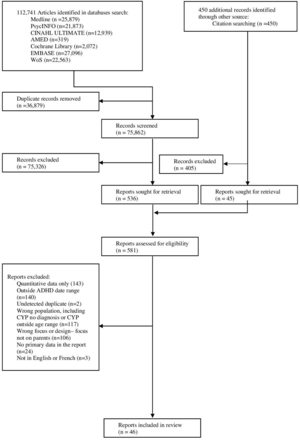Study selection and analysis
This is a systematic review of qualitative papers. Our published protocol covered both qualitative and quantitative studies,14 with quantitative findings being reported separately.9
Search strategy and selection criteria
MEDLINE, PsycINFO, CINAHL Ultimate, AMED, EMBASE, Web of Science and Cochrane Library (including Cochrane Database of Systematic Reviews, Cochrane Central Register of Controlled Trials, Database of Abstracts of Reviews of Effects, Health Technology Assessment Database and NHS Economic Evaluation Database) were searched by FM, from database inception until 18 September 2024. Boolean operators were used to combine terms related to parents; children and young people; mental health difficulties and needs, experiences, well-being for parents (online supplemental material 1). Searches and study selection were done according to the Preferred Reporting Items for Systematic Reviews and Meta-Analyses (PRISMA).15 Reference lists of included papers were also manually checked.
Inclusion/Exclusion criteria underwent review by a patient public involvement (PPI) group. Input from the PPI group was facilitated by our PPI lead (SG), who recruited interested parents via a peer-support organisation for parents of children with mental health difficulties. To maximise opportunities for involvement, we provided short presentations and discussions in online meetings, including an orientation to the purpose and methods of a literature review, as well as emailed information and receipt of emailed comments, particularly important for those who could not attend scheduled meetings owing to childcare priorities. The information provided was used in discussions within the study team prior to finalising the literature review protocol. Studies were eligible if they were: published in English or French; included qualitative examination of the experiences of parents or the impact on parents of having a CYP aged between 5 and 18 years with a mental health difficulty, with a majority of CYP in the study falling within this age range; included parents of CYP formally diagnosed with one or more of the following mental health difficulties: depression, anxiety disorders, psychoses, oppositional defiant and other externalising disorders, labels of emerging personality disorders, eating disorders and attention deficit (hyperactive) disorders. Following the presentation of options for exclusion criteria, the advice of the PPI group was used to create the final decision. Studies were excluded if they focused solely on special education needs, for example, autism spectrum conditions; included only parents of CYP who self-harm, as these are the subject of another review16 or focused solely on post-traumatic stress disorder, as the potential for shared trauma between CYP and parent means experiences and needs may be different.17 Additionally, studies related to attention deficit hyperactivity disorder (ADHD) published before April 2015 were excluded, due to the identification of a number of existing systematic reviews that covered papers related to ADHD prior to this point.18–20 The findings from these systematic reviews are compared with our findings in the discussion.
At least two reviewers independently screened all titles and abstracts, followed by full-text screening by at least two reviewers (FM, DD, AA, LD). Any disagreements were resolved via a third reviewer. The data were managed using Rayyan.21
Data analysis
For each study, data were extracted by one reviewer, checked by another, with discrepancies resolved through discussion with a third reviewer where necessary (DD, FM, SW, LD). Data were extracted into Excel using a standard form, including: author name, date of publication, country, study design, setting, study aim, parent sample, sample characteristics (including the age and the ethnicity of parent and their CYP characteristics). Results sections describing parental experiences of CYP mental disorders were extracted into NVivo for analysis.22
Results were synthesised by FM and DD, with initial themes discussed with our PPI lead (SG) and PPI group. Enhancing transparency in reporting, the synthesis of quality research guidelines23 and PRISMA were followed (online supplemental material 2,3). thematic meta-synthesis was conducted, as this allows inductive analysis to interpret findings from studies using different methodologies. This is important given the range of study types and our aim to understand parents’ experiences.24 Other approaches require the application of existing frameworks or seek to translate concepts across studies, less aligned with our research question.25 The process included line-by-line coding of the results sections from all included studies, to identify key concepts. From these codes, descriptive themes were developed, grouping codes of similar meaning. Next, analytical themes were developed to bring together and analyse descriptive themes into more explanatory themes.24 Initial analysis and themes were discussed with interest holders (including parents with lived experience from our PPI group, mental health practitioners and expert academics) to develop final themes. Data were examined to explore differences/similarities by CYP diagnosis. Unless specified in the results, themes were observed consistently irrespective of CYP diagnosis.
The quality of each individual study was appraised using the Joanne Briggs Institute Checklist for Qualitative Research.26 Studies were assessed by two reviewers independently; any disagreements were discussed and resolved. No difference in attention or weight was given to studies in the synthesis in relation to the quality appraisal.
Findings
Database searching identified 112 741 records. Removal of duplicates led to 75 862 records, with 536 reports sought for full-text screening, leading to the inclusion of 46 studies. Backward citation searching of included studies led to the screening of 450 records, none of which added to the included studies (figure 1).
Selection of studies. ADHD, attention deficit hyperactivity disorder; CYP, children and young people; WoS, Web of Science.
Included studies focused on parents of CYP with ADHD alone (k=16/46), ADHD or depression (k=1); eating disorders (k=11), depression (k=5), anxiety and depression (k=1); anxiety (k=2), obsessive compulsive disorder (OCD) (k=2), mixed mental health conditions (k=6) and schizophrenia or bipolar (k=2). The majority were from the UK (16/46), the USA (9) or Australia (6). Others were from China (5), Sweden (2), Ireland (2), Turkey (2) and one each from Ethiopia, Tanzania, Israel and Palestine. Typically, semi-structured interviews were used, with thematic analysis dominant. Mean parent ages, where reported, ranged from 21 to 60, with the majority in the mid-late 40s. Five studies were conducted with Chinese populations in China, two with African participants (studies in Ethiopia and Tanzania), one with the ‘ultra-orthodox Jewish’ (study in Israel) community, one with participants described as from the ‘Middle East’ (study in Palestine) and one specifically with ‘African-American’ parents.27 Details were not always provided for parents’ ethnicity; however, overall, the majority of studies described a predominantly White/Caucasian sample, often with no further details. Study characteristics are summarised in table 1.
•
Study characteristics
Critical appraisal of the studies revealed 30% (14/46) had evidence of all quality criteria, with 83% meeting eight or more of the 10 criteria (online supplemental material 4). Where quality was lower, this typically related to elements of reflexivity, including the researcher’s acknowledgement of their culture or theoretical position and influence on the research. Analyses typically focused on establishing the fundamental nature of the parents’ experiences, often with limited links to applied theory either in the analysis or within the discussion.
Parents’ experiences of their CYP’s mental health difficulties were characterised by six themes: (1) support needs and gap; (2) impact on everyday life; (3) altered family dynamics; (4) parental worries and fears; (5) emotional experience of caregivers; (6) self-care paradox. (The appearance of themes in each included study are summarised in online supplemental material 5). Quotes illustrating each theme are provided in table 2.
•
Quotes from included studies to illustrate each theme
Support needs and gaps
Good communication from healthcare services was described as crucial for parents, across CYP diagnoses.28–42 They expected clear communication,35 40 particularly regarding treatment options. Lack of communication and consideration led to resentment of clinicians.33 Parents described feeling disregarded, and that the professionals were unaware of their suffering.43 Parents felt they were considered only during crises,40 but needed support throughout.
A particular need parents described was for information, particularly linked to the challenge of distinguishing ‘normal’ behaviour in relation to CYP development from mental health problems.31 44 45 Information desired was specific to CYP diagnosis and where to find support.29 30 32 34 39 40 46–50 They experienced information overload at the point of diagnosis, followed by a lack of information.47 Parents actively sought information in different modes: books, websites or television.46 48 There was the risk of misinformation40 and distress,51 warranting provision from professionals.29
With respect to differences by CYP diagnosis, healthcare practitioner communication was reported as particularly important for eating disorders, anxiety and OCD,31 33 36 38 40 47 51 with concerns about judgement from clinicians.33 Parents wanted communication that empowered themselves and their child,47 validated their distress and enabled them to support or co-deliver treatment for their child.36 Similarly, parents experienced a lack of validation and empathy from schools, instead experiencing judgement and again finding that communication only occurred during crises. For parents of CYP with OCD particularly, the schools’ lack of knowledge was described, requiring parents to coordinate education with healthcare.31 40 Some parents of CYP with ADHD reported schools not taking the difficulty seriously,52 or less support for male children.30 37 Parents of CYP with anxiety disorders and OCD described how their children’s difficulties sometimes appeared irrational, requiring more psychoeducation to understand.40 47 Parents wanted resources for themselves, describing the relevant mental health problems and common comorbidities, such as OCD with autism.31 40 47 Parents of children with ADHD were often well informed about ADHD ‘symptoms’, but wanted better understanding of how to control symptoms and strategies to support their parenting self-efficacy.27 28 32 34 41
Impact on everyday life
There were significant demands on parents, often linked to real-world barriers to accessing care for their child: scarcity of services, long waiting lists and long journeys.28 31 36 40 These then impacted time available for activities other than supporting their child, including socialising and household chores. Parents described the overwhelming nature of both their child’s needs and trying to access treatment as draining their energy and resources,40 at times leading to depression and anxiety.53 Financial strain, due to loss or resignation from job, medical bills and poor insurance coverage, was also frequently described.32 36 45 54 One study focused on the impact on working parents, noting the stress inherent in this and a lack of statutory support.55 Study parents adopted strategies from flexibility and compromises to exercising ‘military routine’ to manage the multiple demands. The gendered impact was noted, with typically a greater demand on mothers.31 Impacts on everyday life were highly related to individual circumstances, rather than CYP diagnosis, with the exception of the cost and time linked to compulsions for parents of CYP with OCD.
Altered family dynamics
Parents described altered relationships and roles, with their CYP and wider family.27 29 32 38 39 44 49–51 53 56–64 Conflict with their child was common,65 often arising from misunderstandings of their child’s behaviours, creating a vicious cycle. This led CYP, feeling rejected, to respond with hostility, deepening conflict. At times, parents described trying their best but being perceived by CYP as not understanding.48 Parents expressed high frustration and exhaustion. Physical punishment was their last resort to recover control, leading to shame and guilt.29 32
Conflict between parents was observed, with some feeling judged or judging their spouse/partner’s responses.31 With parents being highly focused on their child’s mental health needs, sometimes other children in the family felt neglected or resentful, leaving parents distressed.56 60
Within the altered family dynamics, there was a shift in parents’ roles. Parents became monitors/observers,60 care coordinators and trainers of others and advocates.27 40 43 60 Parents monitored behaviour in themselves, their CYP and others to avoid triggering an outburst. For potentially life-threatening difficulties, for example, eating disorders and depression, parents were more attentive to their children’s symptoms and behaviour, protecting to the point of becoming overbearing.59 Parents talked about feeling helpless in these roles, deepened by a lack of support from professionals.43 Furthermore, parents of CYP with eating disorders and OCD may be asked to support, co-provide or lead therapy. Many expressed difficulty with this, owing to their own emotional state. Some felt they lacked confidence to make required decisions.39 Parents of children with OCD described not trusting their judgement, owing to the risk of inadvertently perpetuating their child’s symptoms.31 40 These role changes were enacted by a subjugation of parents’ own needs.30
Parental worries and fears
Parents expressed a range of worries, particularly anxiety about the immediate future, including topics of making friends, academic success, chances to marry and long-term concerns, particularly focused on stigma linked to being labelled with a mental health condition.32 47 66 Parents expressed worries about safety and relapses.49 53 57 67 68 These thoughts were frequent and disruptive: “You wake up thinking about it and checking your phone in breaks at work and thinking is she alright”.53 Owing to risks associated with eating disorders and depression, these parents discussed their child’s future with gravity. Parents feared the death of their child, by eating disorder or suicide and felt powerlessness to protect their child.49 Some parents described trauma from the realisation of the risk and the life-threatening nature of their child’s difficulties.
Emotional experience of caregivers
Parents’ emotional experiences extended beyond worry. Acute emotional distress was evident in parents’ vocabulary and expression: ‘overwhelmed’, ‘exhausted’, ‘draining’, ‘living nightmare’.46 48 56 58 Parents experienced insomnia and felt paralysed.29 56
Parents described how society perceived their CYP’s mental health problems, judging them and lacking sensitivity.30 37 Many described feeling blamed, guilt and shame.42 62 Blame was common, from healthcare, school, other parents, family and partners.48 57 61–63 In addition to stigma from others,69 some parents described internalised stigma about having a CYP with a mental health problem, increasing their sense of responsibility to fix distress.42 Parents expressed blaming themselves and doubting their aptitude as caregivers.53 70 They felt powerless, impacting parenting self-efficacy.35 57 66
Parents described a sense of failing their CYP,43 66 reducing parenting self-efficacy further and creating significant guilt and tension. The impact of this was significant: most parents described withdrawing from social interaction to protect themselves,42 51 which some study participants linked clearly to avoiding others and doubting themselves.70 These feelings linked to frustration, with the situation and the lack of priority given to mental health compared with physical health,40 and particularly for parents of children with ADHD.30 61 In some studies, issues of shame were linked to the cultural meaning of the child’s difficulties as a parents’ failure and not something where support from others is provided.31 69 Chronic impacts were seen, particularly with parents of CYP with eating disorders and depression, who described having to process the risk of their CYP’s death, grief and sorrow.53 63 This chronic sadness related to the loss of a healthy child and/or of the child’s imagined future, which they feared or now knew would not be possible.49 53
Self-care paradox
Considering self-care, parents described the paradox of reduction in self-care owing to significant other demands, together with a need for greater self-care. Parents across all CYP diagnoses shared that their priority was the well-being of their youth. Some parents mentioned being encouraged to self-care; however, they described how their sense of guilt, shame or embarrassment made this difficult. Parents typically only sought help for themselves and their family due to a crisis.50 The focus was on physical needs (sleep, food). Some did recognise that they needed to take a time out,40 with evidence of use of existing coping mechanisms, such as prayer for spiritual well-being.71 In many cases, parents wanted to do something ‘normal’ to find a break from the stresses.35 This was important for the whole family. Parents of children with eating disorders and ADHD diagnosis emphasised the need for peer support and a safe space to share their experiences.35 38 60


